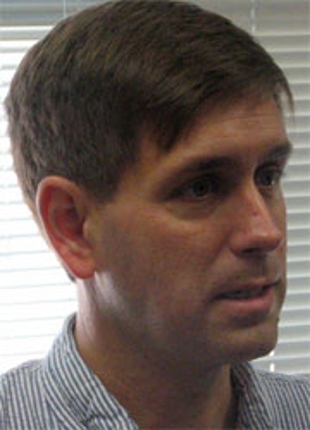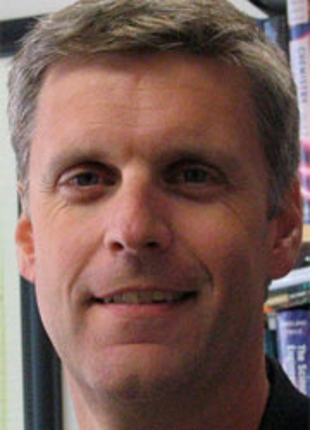Striking Gold: Student Research Leads to Chance Discovery
JMU NewsGetting gold film to adhere to plastics is a tricky task. Finding a sure-fire, low-cost way to accomplish it would be a real breakthrough for a number of industries from biomedicine to computer chip manufacturers.

Chris Hughes, professor of physics and astronomy
A pair of JMU researchers thought they and a High Point University student had stumbled upon the perfect method during the summer of 2009 while working on a biomedical device to replicate DNA. The solution: Use a solvent to dissolve a polymer and create a silicon oxide layer that the gold would stick to. It worked like a charm. But their excitement was short-lived when a JMU student the following fall could not replicate the experiment.
After closer evaluation of the steps each student used, Brian Augustine, professor of chemistry, and Chris Hughes, professor of physics and astronomy, noticed the students had used different solvents in the process. Laura Lee, a High Point University student who participated in JMU's summer Research Experience for Undergraduates program, used chloroform; Alan Mo, a JMU biology major, used toluene.
"They're both very common organic solvents, there would be no reason why you would choose one over the other," Hughes said.
Added Augustine, "He (Alan Mo) asked what to do and we said just get something that dissolves the polymer. Pick toluene. That's as good as anything."
The real head scratching began when Mo repeated the experiment using chloroform and it worked.
"Our reaction was, 'Come on. Do it again,'" an incredulous Augustine said. "We couldn't believe that. That was ridiculous. That should have no effect whatsoever."
More experiments with a variety of solvents proved that chloroform did indeed make the difference. That resolved the problem of finding a simple, low-cost method for getting gold to stick to plastics, but it created a mystery—what was different about chloroform than the other solvents.
"We had some kind of goofy theories," Augustine said. "When you sort of think about them, you say, 'How can all those atoms move in just the right way? Why would the solvent do that? Why would it stay that way?'"

Brian Augustine,
professor of chemistry
To find out, Augustine and Hughes had a third student, Vezekile "Veve" Zungu, a visiting student from South Africa during summer 2010, use spectroscopy to investigate what was happening with chloroform.
"Once you understand the why, then you can start making predictions about other things that can happen," Augustine said. "Now we understand, I think, the basic science or the mechanism behind it so now we can start making predictions about other metals that we think are going to stick or other polymers that we think are going to work."
And that could be big news for a variety of industries. "One of the show-stoppers for plastic tech devices is putting electrical contacts down onto plastic surfaces," Augustine said. "Intel and all the other big players out there, they're trying to move to plastic electronics or at least some subset of their operation is trying to go to plastic electronics," which are light, durable and less costly to manufacture than silicon-based technologies. "The whole biomedical industry, think about implants and stuff like that. Acrylic is an FDA-approved material to go inside of the body, so you can put implants into the body with electrodes that are maybe sensing glucose levels or whatever."
"And there will be things we haven't thought of yet that will be made out of plastic because you can make them out of plastic where you couldn't do it with a silicon-based technology," Hughes said.
A provisional patent application has been filed for the process.
The findings about the chemical reactions are going into a research paper that will be submitted to a top-tier journal. The first paper to come out of the research was published in March in The Journal of Vacuum Science and Technology A. That paper, which was among the top 20 most downloaded articles from JVST in the two months following its publication, dealt more with the discovery of a better process to get gold to stick to plastic than with the details of the chemistry making it happen.
"That paper was the work of Laura Lee basically discovering that chloroform has some effect, although she didn't know that, Alan really figuring out that it was chloroform that was doing it and then Veve doing a little bit of spectroscopy to figure out there's some sort of chemistry happening in there," Augustine said.
All three students were co-authors of the paper along with Augustine, Hughes and JMU chemistry Professor Tom DeVore. The research was significant enough that a quarterly newsletter for American Vacuum Society members chose it as one of three research papers to feature in June out of the hundreds that were published in the various chemistry journals. The AVS has more than 4,000 members in industry, academia and government laboratories.
"It's a very significant thing from the applied technology side of things," Hughes said. "But then the basic science of why this is happening is also interesting. And those are two different audiences that are met by different journals. And that's kind of the way we ended up segregating things."
Hughes also noted that the research environment at JMU had a lot to do with the opportunity to go beyond just finding a method that worked. "Other places, particularly industrial labs or national labs, but also most grad schools these days, if they had come to a point like we were, where they were trying to develop a device and ran into that problem, the device is supreme. You have someone you need to make that device for, or if it's a grad student, they have to get it made for their dissertation. It's much more likely that someone would just say, 'Well, let's just find a work-around and get the job done.' Where we paused and said, 'What the heck is going on here?' And we have the freedom to do that."
The JMU research resulted from a collaboration with the University of Virginia, which wanted gold film to work as mirrors inside a polymerase chain reaction (PCR) device used to amplify DNA, and has received funding from the National Science Foundation.
Related Content

